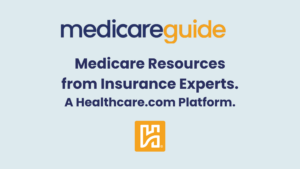Written by Michael LaPick
Healthcare Writer
We aim to help you make informed healthcare decisions. While this post may contain links to lead generation forms, this won’t influence our writing. We follow strict editorial standards to give you the most accurate and unbiased information.
Older Americans are increasingly seeking affordable, quality healthcare, with 10,000 Baby Boomers turning 65 every day. By 2050, 20% of the U.S. population will be over this age.
Medicare is crucial for the nearly 63 million adults enrolled in 2020, but care quality varies by location.
MedicareGuide, a Healthcare.com educational resource site, analyzed factors like prescription drug prices, doctor availability, and life expectancy to rank all 50 states and Washington, D.C., based on cost, access, and quality.
We also consulted four experts to address key questions and offer Medicare advice.
Compare options HERE & start your health plan journey.
Read on for our findings and methodology.
| Overall Rank | State | Total Score | Cost | Quality | Access |
|---|---|---|---|---|---|
| 1 | Minnesota | 66.70 | 20.60 | 22.31 | 23.79 |
| 2 | North Dakota | 65.02 | 20.03 | 21.84 | 23.15 |
| 3 | Massachusetts | 62.17 | 15.62 | 27.25 | 19.30 |
| 4 | California | 61.72 | 21.42 | 23.61 | 16.68 |
| 5 | Nebraska | 61.55 | 17.33 | 22.31 | 21.91 |
| 6 | Hawaii | 60.85 | 17.50 | 26.60 | 16.75 |
| 7 | Montana | 60.61 | 19.46 | 22.21 | 18.94 |
| 8 | Colorado | 60.53 | 19.87 | 23.89 | 16.77 |
| 9 | Iowa | 60.41 | 20.52 | 18.85 | 21.04 |
| 10 | Connecticut | 60.02 | 9.98 | 28.00 | 22.04 |
| 11 | New Hampshire | 58.94 | 16.35 | 22.77 | 19.82 |
| 12 | Maine | 58.70 | 14.88 | 17.27 | 26.55 |
| 13 | New Jersey | 57.83 | 16.03 | 27.16 | 14.65 |
| 14 | Utah | 57.38 | 25.10 | 21.75 | 10.54 |
| 15 | Arizona | 57.34 | 20.28 | 22.12 | 14.94 |
| 16 | Rhode Island | 56.97 | 19.21 | 18.11 | 19.64 |
| 17 | Idaho | 56.46 | 17.66 | 20.44 | 18.35 |
| 18 | New Mexico | 56.02 | 20.11 | 17.55 | 18.35 |
| 19 | Vermont | 55.23 | 10.96 | 19.60 | 24.68 |
| 20 | Kansas | 54.84 | 21.01 | 16.43 | 17.40 |
| 21 | Wisconsin | 54.29 | 18.07 | 17.64 | 18.58 |
| 22 | Pennsylvania | 53.93 | 17.66 | 16.52 | 19.75 |
| 23 | Florida | 53.89 | 16.19 | 22.03 | 15.67 |
| 24 | South Dakota | 53.54 | 17.09 | 17.08 | 19.37 |
| 25 | Washington | 52.20 | 19.54 | 18.29 | 14.36 |
| 26 | Oregon | 51.63 | 16.60 | 17.55 | 17.49 |
| 27 | New York | 51.35 | 11.04 | 26.60 | 13.72 |
| 28 | Alaska | 51.13 | 12.51 | 23.80 | 14.82 |
| 29 | Wyoming | 50.74 | 15.13 | 19.51 | 16.11 |
| 30 | Illinois | 50.72 | 17.99 | 18.01 | 14.72 |
| 31 | Michigan | 49.71 | 18.07 | 11.76 | 19.88 |
| 32 | Virginia | 48.17 | 17.58 | 18.76 | 11.83 |
| 33 | Missouri | 48.12 | 19.38 | 10.83 | 17.91 |
| 34 | Ohio | 47.96 | 20.03 | 10.73 | 17.19 |
| 35 | Texas | 45.94 | 18.23 | 14.93 | 12.77 |
| 36 | Arkansas | 44.48 | 20.20 | 8.40 | 15.89 |
| 37 | Nevada | 44.30 | 19.71 | 14.65 | 9.94 |
| 38 | Indiana | 44.19 | 18.48 | 12.23 | 13.49 |
| 39 | Maryland | 43.65 | 11.04 | 18.11 | 14.51 |
| 40 | Kentucky | 42.75 | 17.33 | 9.24 | 16.18 |
| 41 | Delaware | 42.50 | 8.91 | 17.55 | 16.04 |
| 42 | South Carolina | 41.13 | 21.42 | 9.33 | 10.38 |
| 43 | Tennessee | 39.70 | 15.94 | 7.28 | 16.48 |
| 44 | Alabama | 39.30 | 14.72 | 7.19 | 17.39 |
| 45 | North Carolina | 39.20 | 15.94 | 11.95 | 11.31 |
| 46 | West Virginia | 38.81 | 9.65 | 6.53 | 22.63 |
| 47 | Louisiana | 38.75 | 16.68 | 7.84 | 14.23 |
| 48 | Mississippi | 38.09 | 18.40 | 4.39 | 15.31 |
| 49 | District of Columbia | 38.04 | 8.50 | 10.83 | 18.71 |
| 50 | Georgia | 35.36 | 14.80 | 10.55 | 10.01 |
| 51 | Oklahoma | 34.74 | 16.52 | 5.88 | 12.34 |
COST
- Prescription Drug Prices Per Capita
Best: North Dakota
Worst: Tennessee
- Average Deductible for a Part D PDP plan
Best: Missouri
Worst: Illinois
- Average Medicare Supplement Premium
Best: New Mexico
Worst: Connecticut
- Nursing/Assisted Living Home Per Capita
Best: Wisconsin
Worst: Vermont
- Average Medicare Advantage Max-Out-of-Pocket Amount
Best: California
Worst: Wyoming
- Average Medicare Advantage Premium
Best: South Carolina
Worst: North Carolina
- Out-of-Pocket Medical Spending
Best: Utah
Worst: Washington, D.C.
- Average Monthly Insurance Premium
Best: Minnesota
Worst: Wyoming
QUALITY
- Average Life Expectancy at Birth
Best: Hawaii
Worst: Mississippi
- Fall Deaths per 100,000
Best: Alabama
Worst: Wisconsin
- Percentage of Adults with Type 2 Diabetes
Best: Colorado
Worst: Alabama
- Heart Disease Mortality
Best: Minnesota
Worst: Oklahoma
- Cancer Mortality
Best: Utah
Worst: Mississippi
- Stroke Mortality
Best: New York
Worst: Mississippi
- Alzheimer’s Mortality
Best: New York
Worst: Mississippi
ACCESS
- Number of PDP Plans
Best: California
Worst: Alaska
- Geriatricians Per Capita
Best: Hawaii
Worst: Idaho
- Physicians per Capita
Best: Washington, D.C.
Worst: Mississippi
- Nurse Practitioners Per Capita
Best: Connecticut
Worst: Hawaii
- Home Health Aides Per Capita
Best: New York
Worst: Florida
- Skilled Nursing Facilities Per Capita
Best: Vermont
Worst: New York
- Medicare Rural Health Clinics Per Capita
Best: Nebraska
Worst: Maryland
- Share of Doctors Who Opt out of Medicare
Best: North Dakota
Worst: California
- Public Hospital System Quality
Best: Hawaii
Worst: Louisana
Best States for Elderly Healthcare: Countdown
Compare options HERE & start your health plan journey.
Expert Panel
As seniors expect constant changes to their healthcare, we asked five experts to weigh in with their thoughts to these questions:
- What are cost-saving tips for seniors who need healthcare?
- What should you consider when picking a health plan?
- What can you expect as you become eligible for Medicare?
- What are common misconceptions about Medicare? Healthcare?
- What’s the future of Medicare?

Kev Coleman
President/AssociationHealthPlans.com
What are cost-saving tips for seniors who need healthcare?
While there are no one-size-fits-all savings tips for healthcare, there are a handful of general principles that can minimize your out-of-pocket costs. The first rule is to use your health plan’s in-network healthcare providers except in instances where there is a compelling medical reason to go out-of-network. Out-of-network care is more expensive and may not be covered at all depending on the health plan rules for non-emergency situations. A similar recommendation is to use drugs that are on the health plan’s formulary (i.e. the list of covered prescription drugs). However, it is always worthwhile to compare prices on a website such as GoodRx to see if your medication can be purchased for a price lower than your health plan’s copayment. Another important discipline for the savvy healthcare consumer is to review every medical bill you receive because billing errors happen more frequently than you would suspect.
What should you consider when picking a health plan?
Some of the key attributes for a health plan are: network quality, breadth of drug coverage, reasonable out-of-pocket costs, comprehensive benefits design, and an affordable annual cap on out-of-pocket costs. Since a health plan is only as good as the doctors and hospitals that accept it, verify network participation by your regular doctors and specialists as well as top-quality teaching hospitals and cancer centers. Breadth of drug coverage is important because medication expenses may cost more annually than your doctor care. Comprehensive benefits are important because you do not want holes in your insurance coverage that leave you paying big bills without insurance assistance. Coverage of pre-existing conditions, which is part of comprehensive coverage, is another vital aspect of quality benefit design for a long-term health plan. Lastly, review the MOOP of your intended health plan. The MOOP (Maximum Out-of-Pocket) is the cap on patient spending for covered services obtained in-network (some plans have a separate, more expensive MOOP for out-of-network care).
What can you expect as you become eligible for Medicare?
Medicare’s Initial Enrollment Period (IEP) begins three months prior to a person’s 65th birthday and concludes three months after this birthday. Long before a person becomes eligible for Medicare’s IEP, he or she will likely receive a deluge of direct mail and other marketing materials about Medicare from insurance companies. The Centers for Medicare & Medicaid Services will also mail you a book entitled “Medicare & You” providing an overview of original Medicare, Medicare Part D (prescription drug coverage), and Medicare Supplement (also known as Medigap). If you aren’t already receiving Social Security checks before IEP, you’ll need to sign up for Medicare online manually or reach out to the Social Security Administration. Another critically important task during the IEP is the selection of prescription drug insurance. This coverage can come in the form of a stand-alone Medicare Part D plan or a Medicare Advantage plan, the latter combining prescription drug coverage with a networked delivery of Medicare Part A and B benefits. Failure to enroll in Part D coverage (assuming you lack alternative drug coverage as good as Part D) will result in a late enrollment penalty. The penalty multiplies 1% of the “national base beneficiary premium” of Medicare Part D times the number of months a Medicare-eligible person lacked Part D insurance. This penalty starts when you finally enroll in Part D and continues for as long as you have a Part D plan.
What are common misconceptions about Medicare? Healthcare?
A common misconception about American healthcare is consistency. The quality of medical care (and resulting health outcomes) can vary significantly from one provider to another. Moreover, just because a hospital is renowned for a particular specialty (e.g. orthopedic surgery) does not mean the other specialties in that hospital are of the same quality.
Cost varies as much as quality in healthcare as well. Unfortunately, a higher price for a procedure (such as a knee replacement) does not mean it will be higher quality than the same procedure obtained from a lower cost provider.
What’s the future of Medicare?
At the time of writing, the future of Medicare is more unclear than at any time since the Medicare Modernization Act. The present Biden Administration has advocated lowering the age of Medicare eligibility to 60. Should this proposal be legislatively enacted, it may increase access to the Medicare program for another 23 million Americans. Several unanswered questions attend this Medicare expansion. For example, will Medicare Advantage and Medicare Supplement plans be made available to this younger Medicare population? More importantly, how will the expansion be paid for while simultaneously shoring up the finances of Medicare? The Congressional Budget Office predicts that the Hospital Insurance Trust Fund (which pays for Medicare hospitalization services) will be exhausted by 2024.
Kev Coleman is a well-known healthcare expert whose research and insights have been cited in media outlets ranging from CSPAN and The Wall Street Journal to NPR and Consumer Reports. Mr. Coleman is currently the president of AssociationHealthPlans.com and a contributor to DentalInsurance.com.

Frank Lalli
Author/Health correspondent for Parade and NPR
What are cost-saving tips for seniors who need healthcare?
The biggest mistake people make shopping for health plans is focusing on the premium costs. Fact is, if the premium is low, the health plan operator raises other
elements to maintain its profits. So generally, the lower the premium, the higher your co-payments or percentage of cost-sharing for other provider services, the higher your deductible before the company kicks in a dime – and the smaller the provider network. Therefore, take a holistic approach. If you’re young and healthy, a lower-premium plan can work for you because you rarely need to see a doctor, perhaps not even for an annual check-up. On the other hand, if you have health issues, you may well get a better outcome spending extra to get access to the doctors and specialists you need to stay well.
If you have health insurance at work, as most Americans do, by law the insurance must pay at least 60% of your medical expenses. Also, the premiums cannot cost you more than 9.6% of your income. For instance, if you make $50,000, you should pay not a penny more than $400 in monthly premiums. If you suspect that your employer is breaking these laws, call the Health Insurance Marketplace at 800-318-2596 and ask for an “eligibility determination”. If that inquiry shows you’re being abused, you can sign up immediately for an Affordable Care Act health plan and likely collect federal subsidies that could cut your premiums to $100 a month or less for superior comprehensive coverage.
If you are among the 23 million middle-class Americans buying health insurance on your own, and your family earns less than $100,000, look into buying an Affordable Care Act plan. Beyond the federal subsidies scaled to income that can slash your costs, the plans offer excellent benefits. All ACA plans provide the 10 essential health benefits, including behavioral counseling and maternity care and childbirth. None have annual or lifetime dollar limits on how much the plan must pay for your care. You cannot be turned away, charged extra or dropped because of your health condition, including pre-existing concerns. And you cannot be charged extra because of your gender, including if you are a woman of child-bearing age.
In addition, many workers who have been laid off have traditionally signed up for COBRA (Consolidated Omnibus Budget Reconciliation Act), a national program that allows the worker to keep his or her health plan for up to 36 months if the worker pays the entire costs. The 80% of costs that many companies pay active workers shifts to the laid-off party under COBRA. Now a number of experts say that laid-off workers should turn instead to an Affordable Care Act plan. Laid-off workers are immediately eligible, and their sudden decrease in income often makes them eligible for sizable cost-cutting subsidies.
What can you expect as you become eligible for Medicare?
As you join Medicare, whether Original or Advantage, you will automatically gain access to an array of doctors and services at discounted prices, or no cost to you at all. For example, you can book an annual wellness care visit with your doctor to plan your care at no cost to you. Plus, you become eligible for some 50 or so screening tests, including mammograms and prostate exams, for free.
You need to know that Original Medicare is not cheap. Depending on how long you paid Medicare taxes at work, so-called Part A monthly premiums for hospital care range from $259 to $471 for 2021. And there’s a $1,484 deductible. For doctors under Part B, your premium will be $148, plus a modest $203 deductible. Also, since Medicare pays no more than around 80% of your bills, 9 out of 10 Original members enroll in supplemental Medigap plans that cover the remaining 20%. But Medigap will cost you around $150 to $500 a month in premiums.
What are common misconceptions about Medicare? Healthcare?
The most common Medicare misconception is that most doctors don’t take Medicare patients because of the low government fees that can be half or one-third of what they collect from private insurers or the 10% of patients with no insurance.
And it is true that doctors in big cities with large numbers of potential patients have tended to turn away from Medicare over the years. However, studies show that still up to 90% of doctors and virtually all hospitals accept Medicare. To make sure the doctor or provider you are about to see accepts Medicare, ask this before you book your visit or before, say, the anesthesiologist knocks you out: Are you currently participating in Original Medicare or my specific Medicare Advantage plan? Also, beware of doctors – usually, specialists – who collect their full fee from you upfront, but allow you to keep the Medicare payment – which is commonly around half of what you paid the doctor upfront.
The most common misconception people have about healthcare is that it’s more expensive than they can afford. Around one person in four does not see a doctor,
when they think they should, because of they fear how much the bill will be. Make no mistake, healthcare in the United States is not cheap. But there are many ways for you to get the care you need at affordable prices.
For example, you can get a doctor’s discount if you ask for one. Begin by establishing how much the service will cost you if you proceed. Then state clearly that you cannot afford that amount right now. You may have to show the provider some documents to explain your situation, like pay stubs or your tax return. Still, if you’re sincere in a face-to-face conversation with your providers, many have standing policies of cutting their fees in half for needy people, maybe down to 10%– or even zero. At the least, you should be able to agree on a more manageable monthly payment plan.
You should also shop hospitals for the best rates if you are facing a major procedure, like elective knee surgery or childbirth. Do not approach the billing department. People there are paid to collect money. Instead, meet with the hospital ombudsman, who is expected to advocate for patients. Like doctors, ombudsmen negotiate prices, especially if you come in with competing bids in writing from another hospital or two. One you’ve agreed on terms, get the agreement in writing so there are no misunderstandings later on.
Don’t hesitate to comparison shop prescription prices either. Many local pharmacy store managers, even at chains, will match the lowest price you can find at another store. They’ll often even swap an expired discount coupon for a new one to keep a customer happy and loyal. In addition, the law has changed, and pharmacists now must tell if you if there is a lower-cost medicine available, like an 80%-off generic, rather than the prescription you have – but only if you ask. And you could save up to 90% on your prescription by checking the leading drug discount websites, like GoodRx.com, MilligramRx.com or WeRx.com. For instance, GoodRx claims it saves its average customers $276 a year by price-checking 70,000 pharmacies nationwide for the best prices. You can also appeal directly to drug makers. Virtually all Big Pharma manufacturers maintain extensive assistance programs, even for families in cities earning around $120,000. You can research assistance programs online through Partnerships for Prescription Assistance at PPARx.org.
If you have health insurance with a high deductible before your plan starts paying or hefty 30% or more co-insurance for pricey procedures, consider paying cash. By law, you are not obligated to use your health insurance. Increasingly, providers are accepting less in cash on the spot from patients than they could eventually collect from the insurance company. By taking cash, they avoid piles of insurance paperwork, payment delays and other hassles.
Also, if you earn less than 125% of the national poverty rate, around $27,000 for a family of three, there’s a good chance you qualify for your state’s Medicaid. If you’re eligible, your doctor costs and prescriptions will become virtually zero. In some states, you may be charged a nominal monthly fee, or you may be required to at least be seeking work. Given the high number of layoffs due to the pandemic, don’t overlook inquiring about Medicaid.
What’s the future of Medicare?
Medicare Advantage plans sold by private health insurance companies already account for 40% of all Medicare coverage. And they will continue to grow because they offer all Medicare services, plus extras like free gym memberships and trips to the doctor – all at low premiums, often zero. However, Advantage plans have limited provider networks, often only the providers in one county and no cancer center. Studies show healthy seniors can benefit from Advantage, but seniors with health issues have better outcomes signing up for Original Medicare.
Original Medicare will continue to provide access at low cost to roughly 90% of all doctors, 75% of all specialists and virtually all 5,000 hospitals. Medicare will continue to pay 80% of the bills, and the overwhelming majority of members will continue buying supplemental Medigap insurance to cover the remaining 20%. The good news is that many lawmakers in Congress are pushing to expand Original Medicare benefits to eye care, hearing and dental. Many also continue to advocate for allowing the federal government to begin negotiating lower drug prices from the manufacturers. And lawmakers want to lower the eligibility age for Medicare from age 65 to 60, thereby lowering costs across the board by bringing in younger, healthier seniors.

Elaine Wong Eakin
Health Educator, Healthcare Policy Advocate and Health Insurance Agent
What are cost-saving tips for seniors who need healthcare?
If you are age 65 or older, you are probably eligible for Medicare. Medicare has excellent benefits but does not cover 100% of all benefits. To manage your out-of-pocket costs, consider:
- Enrolling in a Medicare Advantage plan or buying a Medicare Supplement plan. Get guidance from a reputable health agent or your local SHIP.
- Use preferred network pharmacies – Medicare Part D plans network with pharmacies, but not all in-network pharmacies cost the same. Drug prices and copayments at preferred in-network pharmacies are generally lower than at standard in-network pharmacies. Ask your Part D plan about preferred in-network pharmacies.
- Apply for financial assistance programs. Besides Medicaid, other financial assistance programs include Medicare Savings Programs and Extra Help which have higher asset and income limits to qualify. To apply for Medicare Savings Programs, contact your state Medicaid. Apply for Extra Help with Social Security.
What should you consider when picking a health plan?
Coverage, costs, and choice of providers are main considerations when choosing a health plan.
Coverage refers to what is covered, or benefits, as well as how much is covered. Ideally, we want 100% coverage but, realistically, that plan would probably have a high premium.
For prescription drug plans, make sure the plan covers all, or most of, your drugs. Use the Medicare Plan Finder to find Part D plans that cover your drugs.
Costs include premium as well as cost-sharing. Don’t choose a plan with a low premium without checking the coverage or cost-sharing.
Choice of providers refers to doctors as well as pharmacies. With Original Medicare, you may choose from doctors willing to bill Medicare; with Medicare Advantage HMO plans, your choose within the network. With Part D plans, use network pharmacies for lower copayments. For even lower copayments, use preferred network pharmacies instead of standard network pharmacies.
What can you expect as you become eligible for Medicare?
This article is relevant for people who become eligible for Medicare when they turn 65.
Is Medicare enrollment automatic? It depends. Enrollment in Medicare is automatic if you applied for Social Security retirement benefits before you turned 65.
If you did not apply for SS benefits before you turned 65, you need to voluntarily enroll. If you are covered by an employer health plan, you may delay Medicare enrollment without a penalty.
Enroll online at the Social Security website or over the phone at (800) 772-1213.
Enroll during your Initial Enrollment Period (IEP), which starts three months before your birth month and ends three months after your birth month. Don’t miss enrolling during your IEP unless you have employer health coverage.
Enroll in a Medicare Part D or Medicare Advantage plan, or apply for a Medicare Supplement plan during your IEP. Get guidance from a licensed agent or SHIP counselor.
What are common misconceptions about Medicare? Healthcare?
- “When I get Medicare, I won’t have to pay for health insurance.”
Reality: Although Medicare Part A is premium-free for most Medicare consumers, most pay a premium for Part B. Furthermore, Medicare covers 80% for most Part B services, and you are responsible for the remaining 20%. You also have copayments for some Part A benefits. To manage out-of-pocket costs, about 90% of Medicare consumers have a Medicare Supplement or Medicare Advantage plan.
- “Medicare covers if I have to go to a nursing home.”
Reality: Medicare Part A covers a skilled nursing facility if you meet the criteria. Medicare does not cover custodial or non-skilled personal care in a nursing home.
- “When you enroll in Medicare Advantage, you give up your Medicare.”
Reality: Medicare Advantage (MA), aka Part C, and is required to cover Medicare Parts A and B benefits. MA plan members have Parts A and B benefits and additional benefits the MA plan may offer.
What’s the future of Medicare?
Current projections anticipate the Medicare Hospital Trust Fund, which pays Part A benefits, will be insolvent by 2026. Congress needs to act to sustain the Fund beyond 2026, whether to increase revenue or decrease spending or both.
Efforts to curb rising prescription drug prices may come to fruition as the issue becomes a national health concern. The 2003 law that created Medicare Part D prohibited the federal government from negotiating drug prices. Drugmakers supported the prohibition and have successfully defeated proposals to lift it. Allowing the government to negotiate drug prices on behalf of 62 million Medicare beneficiaries will likely lower drug prices for the Part D market and other markets.
The Medicare program will change if the eligibility age is lowered to include more younger people. Even if people younger than 65 without disability are allowed to buy into Medicare, the program will likely change.

Garrett Ball
Owner, Secure Medicare Solutions
What are cost-saving tips for seniors who need healthcare?
Healthcare can be one of the largest line-items in a senior’s budget, so saving money on it is at the forefront of many senior’s minds. A few tips for saving money include using generic medications when available, using in-network medical providers if their Medicare plan has a network, and having regular preventive check-ups to detect early any potential medical issues. It is also a good idea to price-check your health insurance periodically (we recommend at least bi-annually) to ensure that you have the best possible plan for your medical needs and financial resources.
What should you consider when picking a health plan?
When you are selecting a medical plan, it is crucial to look at several significant factors: cost, coverage, and usability. Cost is obviously important but it must be weighed side-by-side with coverage. Particular when considering Medicare plans, some of the lower premium coverage options have more out of pocket exposure. This may work for some people, depending on your health and financial means, but it is something to be aware of before enrolling in a plan. If you are someone who is a regular user of the medical system, it is essential to choose a solid plan when you are in your initial enrollment period (when you turn 65 or start on Medicare), as you may have difficulty switching your plan at a later time. By usability, I am referring to factors like are your doctors in network, is your plan going to cover you if/when you travel, etc. These are factors that differ on some types of Medicare plans.
What can you expect as you become eligible for Medicare?
When you are first eligible for Medicare, you will be inundated with solicitations, many of which look “official”. My recommendation is always to read as much as you feel comfortable with but not to get bogged down in trying to read every last piece of information that comes your way. Frankly, most of it is sales-motivated instead of education-focused, and this affects the way the information is presented. If you are already receiving Social Security when you turn 65, you will be automatically enrolled in Medicare A & B. If you are not receiving Social Security, you should enroll in Medicare itself about 2-3 months before you turn 65. As far as evaluating and selecting another plan – i.e. Medicare Supplement, Medicare Advantage, or Part D – your options are comparing all the plans yourself through the individual insurance companies or using an independent broker that can help you coalesce and understand the information and make an informed choice.
What are common misconceptions about Medicare? Healthcare?
One of the most common misconceptions of Medicare that I see regularly is that Medicare covers everything and that is all you “need”. Unfortunately, Medicare does have some holes and out-of-pocket costs. For example, it does not cover anything on routine dental or vision. Also, traditional Medicare does not cover medications – you have to sign up for a separate Part D prescription drug plan to have prescription coverage. Additionally, Medicare has deductibles and coinsurance amounts that you are responsible for if you do not have a supplement plan. Another misconception that I run into about Medicare is that it is going to be free. Although your payroll tax dollars greatly subsidize the Medicare premium, it is not altogether free – current premiums for Medicare Part B are $148.50/mo for most income levels. While not “full” coverage or free, surveys consistently show that most people are very happy with the coverage they receive from Medicare.
What’s the future of Medicare?
I would say that the future of Medicare is somewhat uncertain. The most recent numbers from the Congressional Budget Office in December 2020 said that the Medicare trust fund would be exhausted in 2024. Certainly, the “Silver Tsunami” of Baby Boomers reaching Medicare eligibility has put a strain on the system. That said, there have been proclamations about Medicare running out of money for years now, and it is continuously thought of as political unviable to allow that to happen. So what does that mean? Most likely, in my opinion, there will be increases in cost or decreases in coverage (or both) in coming years to continue to kick the can down the road. The other variable are recent proposals for expanding Medicare, which would bring into play a whole new set of circumstances and financial requirements to keep the program solvent.

Diane Omdahl
Nationally Recognized Medicare Expert, RN, Serial Entrepreneur
What can you expect as you become eligible for Medicare?
My first piece of advice if you’re approaching age 65: Buy a bigger mailbox. You’re going to get mail from companies selling every type of Medicare coverage imaginable. My second piece of advice: Put it into one big pile to review at a later date. Take time to figure out Medicare – what you need, how it will work for you. Then, after you understand those basics, you can investigate plans.
What are common misconceptions about Medicare?
Here are two very common myths.
#1. Medicare is free.
Ask anyone on Medicare and you’ll learn it is far from free. Everyone must pay the standard monthly Part B premium, $148.50 this year. Higher-income beneficiaries will pay more. Medicare supplement, Part D drug plans, and some Medicare Advantage plans have premiums. No matter which of these you choose, you’ll face cost-sharing in the form of deductibles, copayments, and coinsurance.
#2. Pre-existing medical conditions do not have an impact on your ability to get Medicare coverage.
That might apply to coverage for those under age 65. However, once on Medicare, pre-existing conditions can have an impact on one’s ability to get a Medicare supplement plan. After being enrolled in Part B for six months, an insurer can deny an application or raise premiums because of medical issues. (A few states have more generous rules.)
Methodology
In order to determine the best and worst states for elderly healthcare, MedicareGuide compared the 50 states and the District of Columbia across three key categories: 1) Cost, 2) Access and 3) Quality.
We evaluated those categories using 24 relevant metrics, which are detailed below. Each metric was graded on a 100-point scale, with a score of 100 representing the best elderly healthcare at the most affordable cost.
Lastly, we determined each state and the District’s weighted average across all metrics to calculate its overall score and used the resulting scores to rank-order our sample.
Cost – Total Points: 33.33
- Average Monthly Insurance Premium: Full Weight
- Share of High Out-of-Pocket Medical Spending: Full Weight
- Prescription Drug Prices Per Capita: Full Weight
- Nursing/Assisted Living Home Per Capita: Full Weight
- Average Medicare Supp Premium of Plans: Full Weight
- Average Medicare Advantage Premium of Plans: Full Weight
- Average Max Out-of-Pocket for Medicare Advantage Plans: Full Weight
- Average Part D Deductible: Full Weight
Access – Total Points: 33.33
- Quality of Public Hospital System: Full Weight
- Note: This metric is based on the Centers for Medicare & Medicaid Services’ ranking of public hospital systems.
- Physicians Per Capita: Full Weight
- Geriatricians Per Capita: Full Weight
- Nurse Practitioners Per Capita: Full Weight
- Home Health Aides Per Capita: Full Weight
- Skilled Nursing Facilities Per Capita: Full Weight
- Medicare Certified Rural Health Clinics Per Rural Population: Full Weight
- Share of Doctors Who Opt out of Medicare: Full Weight
- Number of Part D Plans Per State: Full Weight
Quality – Total Points: 33.33
- Alzheimer’s Disease Rate: Full Weight
- Life Expectancy: Full Weight
- Cancer Mortality Rate: Full Weight
- Stroke Disease Rate: Full Weight
- Heart Disease Rate: Full Weight
- Share of Adults with Type 2 Diabetes: Full Weight
- Fall Deaths Rate Per 100,000: Full Weight
Sources: Data used to create this ranking were collected from the U.S. Census Bureau, U.S. Bureau of Labor Statistics, Kaiser Family Foundation, Center for Medicare & Medicaid Services (CMS), Centers for Disease Control and Prevention (CDC), Association of Medical Colleges (AAMC), American Geriatrics Society, SNFdata Resources and MedicareGuide research.
Thank you for your feedback!







